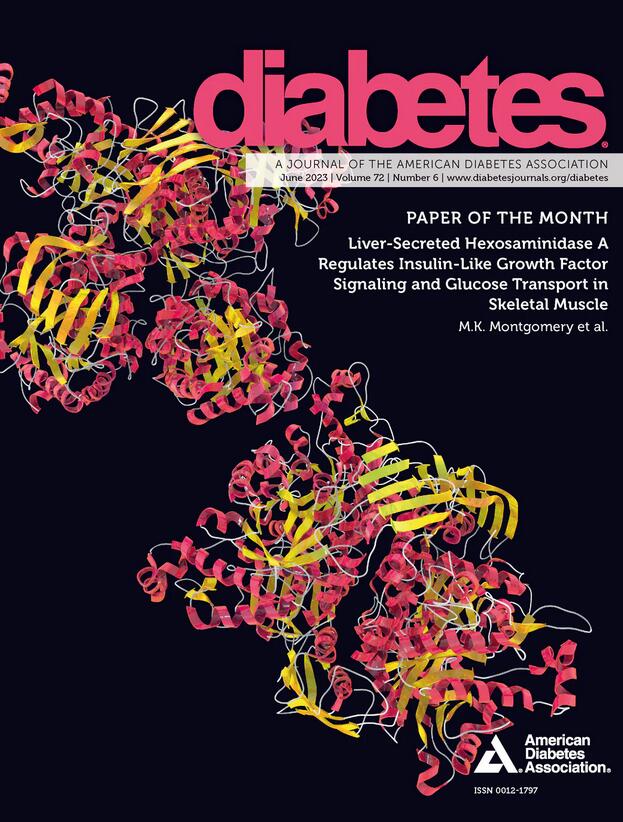1786-P: Trends in Diagnosed Diabetes Prevalence across Anthropometric Measurements in the United States, 2001–2023
IF 7.5
1区 医学
Q1 ENDOCRINOLOGY & METABOLISM
引用次数: 0
Abstract
Introduction and Objective: To assess trends in prevalence of diagnosed diabetes during 2001-2023 across categories of three anthropometric measures: BMI, waist circumference (WC), and waist-to-height ratio (WHtR). Methods: Data were from the National Health and Nutrition Examination Survey from 2001-2023 for 53,450 participants aged ≥ 20 years. Diagnosed diabetes (DM) was defined based on self-reported physician diagnosis. Age-standardized prevalence of DM and annual percentage change (APC) were estimated by anthropometric categories. Results: Between 2001-2004 and 2021-2023, the age-standardized prevalence of DM increased from 5.7% to 7.9% among those with BMI 25 - 29.9 kg/m² (APC: 2.2%, P < 0.05) and from 12.1% to 14.8% in those with BMI ≥30 kg/m² (APC: 1.1%, P < 0.05), with no significant changes for BMI <25 kg/m². DM prevalence increased from 9.3% to 13.0% in the high WC (≥102cm for men and ≥88cm for women) group (APC: 1.6%, P < 0.05) and from 11.7% to 15.2% in the high WHtR (≥0.6) group (APC: 1.3%, P < 0.05). Changes in DM over time for moderate WC and WHtR were not significant. Conclusion: Prevalence estimates for DM were higher after 2017-2020 than in 2001-2004 for all anthropometric categories. The growing prevalence of DM in individuals with higher BMI, WC, and WHtR highlights the significant role of adiposity in diabetes risk in the U.S. Disclosure D. Choi: None. S.J. Onufrak: None. I. Zaganjor: None. J.M. Lawrence: None. S. Han: None. K.M. Bullard: None. L. Kompaniyets: None. M.E. Pavkov: None.1786-P: 2001-2023年美国糖尿病诊断趋势
前言和目的:评估2001-2023年间诊断糖尿病的流行趋势,通过三种人体测量指标:BMI、腰围(WC)和腰高比(WHtR)。方法:数据来自2001-2023年全国健康与营养检查调查,53,450名年龄≥20岁的参与者。诊断糖尿病(DM)是根据自我报告的医师诊断来定义的。通过人体测量分类估计糖尿病的年龄标准化患病率和年百分比变化(APC)。结果:2001-2004年和2021-2023年,BMI 25 - 29.9 kg/m²人群中糖尿病的年龄标准化患病率从5.7%上升到7.9% (APC: 2.2%, P <;0.05), BMI≥30 kg/m²的患病率为12.1% ~ 14.8% (APC: 1.1%, P <;0.05), BMI在25 kg/m²时无显著变化。糖尿病患病率在高腰围组(男性≥102cm,女性≥88cm)从9.3%增加到13.0% (APC: 1.6%, P <;高WHtR(≥0.6)组从11.7%增至15.2% (APC: 1.3%, P <;0.05)。中度WC和WHtR的DM随时间变化不显著。结论:2017-2020年之后,糖尿病的患病率估计高于2001-2004年所有人体测量类别。在BMI、WC和WHtR较高的个体中,糖尿病的患病率不断上升,这突出了肥胖在美国糖尿病风险中的重要作用。S.J.奥努弗拉克:没有。I. Zaganjor:没有。J.M.劳伦斯:没有。韩:没有。布拉德:没有。L. Kompaniyets:没有。M.E. Pavkov:没有。
本文章由计算机程序翻译,如有差异,请以英文原文为准。
求助全文
约1分钟内获得全文
求助全文
来源期刊

Diabetes
医学-内分泌学与代谢
CiteScore
12.50
自引率
2.60%
发文量
1968
审稿时长
1 months
期刊介绍:
Diabetes is a scientific journal that publishes original research exploring the physiological and pathophysiological aspects of diabetes mellitus. We encourage submissions of manuscripts pertaining to laboratory, animal, or human research, covering a wide range of topics. Our primary focus is on investigative reports investigating various aspects such as the development and progression of diabetes, along with its associated complications. We also welcome studies delving into normal and pathological pancreatic islet function and intermediary metabolism, as well as exploring the mechanisms of drug and hormone action from a pharmacological perspective. Additionally, we encourage submissions that delve into the biochemical and molecular aspects of both normal and abnormal biological processes.
However, it is important to note that we do not publish studies relating to diabetes education or the application of accepted therapeutic and diagnostic approaches to patients with diabetes mellitus. Our aim is to provide a platform for research that contributes to advancing our understanding of the underlying mechanisms and processes of diabetes.
 求助内容:
求助内容: 应助结果提醒方式:
应助结果提醒方式:


